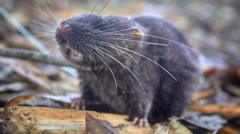In a groundbreaking expedition to the Alto Mayo region of northern Peru, a team led by Conservation International has unveiled an astonishing variety of new species, including an amphibious mouse with webbed feet and a bizarre "blob-headed" fish. This area, which encompasses parts of the Amazon rainforest, serves as a sanctuary for diverse ecosystems but is also under pressure from human activities such as deforestation and agricultural expansion.
The expedition discovered a total of 27 new species, consisting of mammals, fish, amphibians, and butterflies, highlighting the rich biodiversity of the region. Trond Larsen, senior director at Conservation International, expressed astonishment at the discovery, especially in a human-influenced landscape. Local indigenous groups contributed significantly to the research; Yulisa Tuwi, an Awajún woman, emphasized that the findings empower their community to safeguard their culture and natural resources.
The expedition documented a new dwarf squirrel species, measuring just 14 cm in length, as well as eight distinct types of fish, three amphibians, and ten butterfly species. One of the most intriguing discoveries was a spiny mouse species, known for the stiff guard hairs that function similarly to spines on a hedgehog. Additionally, the newly identified blob-headed fish was already familiar to the Indigenous Awajún people, showcasing the importance of traditional ecological knowledge.
Amidst these discoveries, a unique climbing salamander was found to exist in small populations, and a tiny arboreal opossum species with large ears was also documented. The research underscores the significance of conservation efforts in preserving not only the region's remarkable biodiversity but also the rich cultural heritage tied to the land.
The expedition discovered a total of 27 new species, consisting of mammals, fish, amphibians, and butterflies, highlighting the rich biodiversity of the region. Trond Larsen, senior director at Conservation International, expressed astonishment at the discovery, especially in a human-influenced landscape. Local indigenous groups contributed significantly to the research; Yulisa Tuwi, an Awajún woman, emphasized that the findings empower their community to safeguard their culture and natural resources.
The expedition documented a new dwarf squirrel species, measuring just 14 cm in length, as well as eight distinct types of fish, three amphibians, and ten butterfly species. One of the most intriguing discoveries was a spiny mouse species, known for the stiff guard hairs that function similarly to spines on a hedgehog. Additionally, the newly identified blob-headed fish was already familiar to the Indigenous Awajún people, showcasing the importance of traditional ecological knowledge.
Amidst these discoveries, a unique climbing salamander was found to exist in small populations, and a tiny arboreal opossum species with large ears was also documented. The research underscores the significance of conservation efforts in preserving not only the region's remarkable biodiversity but also the rich cultural heritage tied to the land.


















